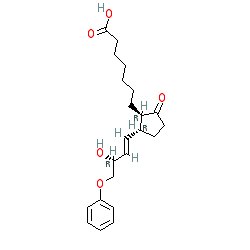GtoPdb is requesting financial support from commercial users. Please see our sustainability page for more information.
|
Synonyms: Dpt-prostaglandin E1 | M&B 28767 | M&B-28767
Compound class:
Synthetic organic
Ligand Activity Visualisation ChartsThese are box plot that provide a unique visualisation, summarising all the activity data for a ligand taken from ChEMBL and GtoPdb across multiple targets and species. Click on a plot to see the median, interquartile range, low and high data points. A value of zero indicates that no data are available. A separate chart is created for each target, and where possible the algorithm tries to merge ChEMBL and GtoPdb targets by matching them on name and UniProt accession, for each available species. However, please note that inconsistency in naming of targets may lead to data for the same target being reported across multiple charts. ✖ |
|
|||||||||||||||||||||||||||||||||||
| References |
|
1. Abramovitz M, Adam M, Boie Y, Carrière M, Denis D, Godbout C, Lamontagne S, Rochette C, Sawyer N, Tremblay NM et al.. (2000)
The utilization of recombinant prostanoid receptors to determine the affinities and selectivities of prostaglandins and related analogs. Biochim Biophys Acta, 1483 (2): 285-93. [PMID:10634944] |
|
2. Boie Y, Stocco R, Sawyer N, Slipetz DM, Ungrin MD, Neuschäfer-Rube F, Püschel GP, Metters KM, Abramovitz M. (1997)
Molecular cloning and characterization of the four rat prostaglandin E2 prostanoid receptor subtypes. Eur J Pharmacol, 340 (2-3): 227-41. [PMID:9537820] |
|
3. Kiriyama M, Ushikubi F, Kobayashi T, Hirata M, Sugimoto Y, Narumiya S. (1997)
Ligand binding specificities of the eight types and subtypes of the mouse prostanoid receptors expressed in Chinese hamster ovary cells. Br J Pharmacol, 122 (2): 217-24. [PMID:9313928] |
|
4. Leduc M, Breton B, Galés C, Le Gouill C, Bouvier M, Chemtob S, Heveker N. (2009)
Functional selectivity of natural and synthetic prostaglandin EP4 receptor ligands. J Pharmacol Exp Ther, 331 (1): 297-307. [PMID:19584306] |
|
5. Stillman BA, Breyer MD, Breyer RM. (1999)
Importance of the extracellular domain for prostaglandin EP(2) receptor function. Mol Pharmacol, 56 (3): 545-51. [PMID:10462542] |







